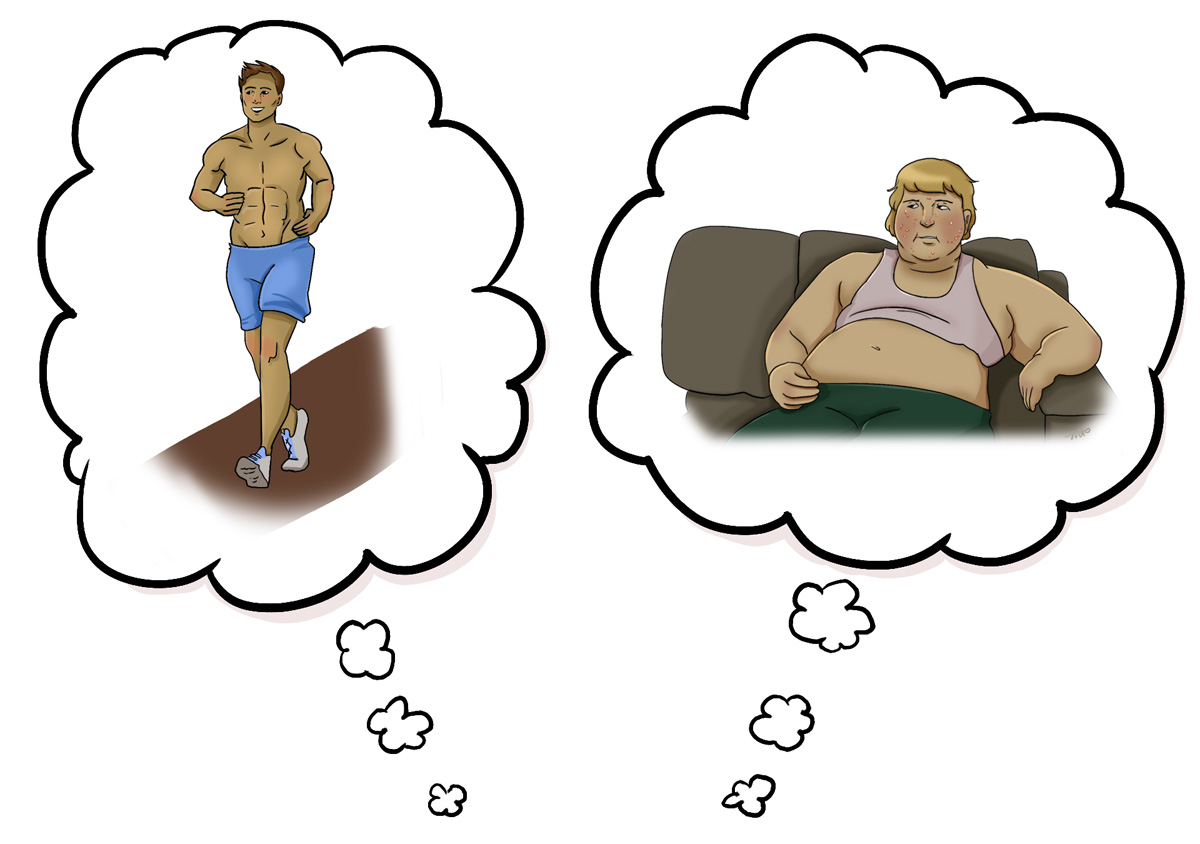Outthink Your Thoughts – How to Get Distance Between You and Your Thoughts
Can you relate to those situations where it’s quite hard to resist your inner lazy voice?
For example, when it’s about doing sports?
It turns out a lot of us do, but you can dramatically increase your level of control over your actions by using some simple psychological methods.
In this article, I will show you two highly effective self-coaching techniques which are easy to use.
Let’s dive right in.
- Method #1 – More Control by Seeing Your Mind as a Suggestion Box
- Your Thoughts Are Only Suggestions – And What You Decide Is Up to You
- The Basics of Getting Ample Distance Between Your Thoughts and You
- The Strength of Willpower in Outthinking Your Thoughts
- Method #2 – Subconscious Power by Using Visualizations
- Visualize Your Future-Self
- Example
- Practicing Voluntary Discomfort
- Be Aware of Your Reaction
- Conclusion – You Have Control
Your thoughts are ever-present and always involved in your journey through life.
You ever tried to outthink your thoughts?
They seem so real and vibrant that we often tend to see them as the very core of our being.
Distance, in this case, will mean more power and self-control over your thoughts and your life.
I invite you to try these different perspectives on your thoughts and observe how beneficial the possible outcomes can be.
Method #1 – More Control by Seeing Your Mind as a Suggestion Box

We tend to take our thoughts very seriously that we often see these thoughts as the reality whenever they cross our mind.
We always identify with these as the truth and if our thought tells us that we are tired and bored, we immediately accept this as it comes.
Why not start seeing things from a new perspective?
Try to see your mind as a suggestion box.
All thoughts coming out of this box are just suggestions.
Now, you can decide if you want to follow these suggestions or not.
Viewing your thoughts from this perspective gives you distance from your thoughts.
By doing this, you’ll be creating space to think about the consequences of acting on the actual thought.
Basically, this is what it means to outthink your thoughts.
Your Thoughts Are Only Suggestions – And What You Decide Is Up to You
What do you do when your mind tells you you’re tired and should stop doing sports?
Do you easily yield or simply thank it for the idea?
While the mind tries to paint the picture of tiredness, this is not what will really stop you.
Rather, it is your belief and perception of such tiredness that will stop you.
Fortunately, from now on, practicing this simple self-coaching technique will help you put your thoughts within your control.

How to Outthink Your Thoughts –
The Basics of Getting Ample Distance Between Your Thoughts and You
You can choose what to believe as well as assign whatever meaning you want to the suggestion that has been brought to your notice.
Whether you see this as a call to stop or as a signal to continue is up to you.
It is likely that there’ll be a great deal of discomfort as you try to accomplish success in different spheres of your life.
You’ll have to make compromises and at times you’ll have to do what you don’t want to do.
When discomfort sets in from the mind, it can be compared to you stepping into a mental gym where your mental resistance training and ability will be put to test.
It takes a lot to be able to control this, but the most important thing involved will be how you see the thoughts going through your mind and what meaning you eventually read to them.
To outthink your thoughts and mentally resist the mind’s calls will involve a great deal of mental clarity and strength.
A lot of things are involved as we’ll see below.
The Strength of Willpower in Outthinking Your Thoughts
Willpower is in many ways similar to muscle power.
The more consistent you are in exercising it, the more it becomes stronger over time.
Exercising your willpower for an extended period will totally turn around how you behave or react to certain situations.
This mental strength will ensure you’re able to easily do things a lot of people dread doing.
In the same way, you’ll be able to exercise self-control to resist what others find impossible to resist.
To achieve extraordinary results in life, this will prove very vital.
Do you want to know the best part?
Method #2 – Subconscious Power by Using Visualizations
Which voice is speaking in your head at the moment?
To outthink your thoughts would require a lot; part of which is the ability to discern who is actually speaking in your head.
Ask yourself:
Which side of me is talking right now?
Is it the lazy couch potato side in you, that is telling you you’re tired so you can avoid doing those exercises?
Or is it your ambitious side which knows how good these sports are and how they will make you feel better afterward?
By so doing, you’ll be able to maintain the right distance between your thoughts and yourself.
To make this even stronger, you can work with pictures additionally.
This technique I use often in my online coaching and the results are stunning.
Visualize Your Future-Self
And Get Some Leverage To Outthink Your Thoughts
Pictures are a powerful tool and will be very effective to reach your subconscious.
Imagine a couch potato side of you with over 50 pounds more bodyweight than you actually have.
Make a clear picture in your head how your face and your body would look in this condition.
Maybe the face looks a lot older with a depressive touch?
The more drastic the picture in your mind, the better it will help you to decide in the right direction.
Thereafter, imagine a second version of yourself; that which looks sportier and healthier than you are at the moment.
Create a clear picture in your mind of this version of yourself too.
Which clothes do you wear in this condition?
Nicer ones looking smart and stylish and your face looking even younger and healthier?
With both pictures clear in your mind now, knowing whose voice to answer should be much easier.
Now, whenever a thought comes, ask yourself which version is actually speaking inside of you.

Example
Imagine the following thought comes to you:
“I don’t do sports today because I’m tired”
Follow the steps below to discern which voice you should listen to;
- ask yourself which version of you is speaking
- bring up the picture of this version in your head
(in this case the heavy overweight version with an unhealthy, old face)
- think about the consequences of following that voice. They will be that you will end up in this picture of you
- ask yourself what the other version of you would say and imagine it’s a picture in your head (in this case: “do sports anyway because I know afterward, I will feel great”)
- then decide carefully which voice you follow
These self-coaching techniques with pictures involve your subconscious and make it easier for you to make decisions in the right direction to outthink your thoughts.
How can you further strengthen your willpower to outthink your thoughts and make the right decisions when the mind is pouring out its suggestions?
Remember we mentioned mental resistance training? How then can we practice this?
Practicing Voluntary Discomfort
Putting yourself through voluntary hardship is the best form of mental resistance training if you’ll want to outthink your thoughts.
This can be done in subtle little ways such as under-dressing for cold weather, taking cold showers, putting off the air conditioner in your car or house, occasional fast in which you’ll drink only water, as well as high-intensity exercises among a host of many other things you can try.
Consistency is key, even in the physical ream so it is important that you pick up one way you’ll eventually commit to.
Also, understand that progress is important and that you don’t have to overwhelm yourself right away. Start small and then improve along the line.
You can even start with simple things like doing five minutes of exercising every morning.
You can also try making it a duty to read a page in a book as well as some other little things.
Be Aware of Your Reaction
If you’re thinking right now that you aren’t the kind of person who practices voluntary discomfort, be aware this is the very voice you’re setting out to control.
To outthink your thoughts, you should understand that this is just a mere suggestion that is very far from being the truth.
Understand that the decision of what to do with such suggestions lies solely within your power regardless of what the mind is saying to you.
Conclusion – You Have Control
Your thoughts are no doubt always present but they have little to no control over what you turn out to do.
As individuals, we should be able to perceive discomfort arising from our thoughts as mental resistance training that we should push through.
Imagining self-coaching techniques help to involve your subconscious which can be a powerful source.
Each time you are able to outthink your thoughts to get through this, you’ll feel stronger.
Consistency at doing this will make it become something of a second nature.
By so doing, it will become easier to outthink your thoughts to do that which you don’t want to do.
You’ll thus become a relentless action taker.
This quality is no doubt needed if you’ll turn your dreams into reality and achieve success in any sphere of life.
On this path, your happiness and joy will grow tremendously.
So, enjoy the process as you set out to become the new you!
If you want to get additional leverage in the process, consider hiring a life coach.
Important Note
Every article I write is intended to help you with:
- questioning and reflecting on your own view of the world
- understanding why you are looking at the world like you do
- finding different perspectives to view situations from different angles, and
- going on a meta-level and reflecting on the consequences of your view
However, with every sentence I write, I create another view of how things “really are”.
Even if I do this with the best intentions, please critically examine if this construction of the reality is helpful for you as an individual person in your own special situation.

